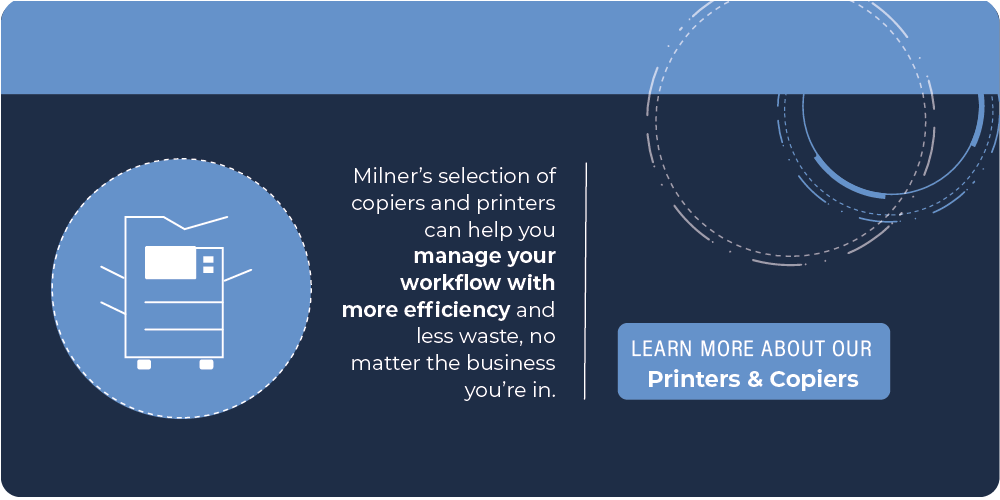
May 4, 2022
According to a new market study published by Global Industry Analysts Inc., published in 2022, the global thermal printing market is expected to reach US$48.8 billion by 2026. As a superior option to traditional impact printers, thermal printing has become a popular choice for POS terminals in the retail, transportation and manufacturing sectors. Supplies, specifically the printing market segment, is dominated by barcode printers segment, and is expected on its own to reach $36.1 billion over the next four years. This segment is expected to command the largest share of the thermal printing market over the next several years due to its extensive usage by small and large companies for tracking and labeling of products. With its combination of data management features, barcoding is highly relevant for a wide range of industrial environments, offering dependable, consistent, and productive operations.
Your business can be part of this growth! Contact Milner to find out how we can partner with you to help your business with the right technology for growth as well as protection.
Thermal transfer printers are particularly useful for businesses that print a large volume of inventory labels, such as barcode labels. In times of high demand for efficiency, like during the busy holiday season, retailers can use thermal printers to print shipping labels quickly. Since thermal stickers are more durable than standard labels, you can use them on surfaces that may get wet or dirty without worrying about them wearing off or peeling away.
Moreover, thermal transfer printers encounter fewer printer issues, such as jams. Images created by thermal printers are more durable and of better quality than those created by impact printers. Their images are clear and long-lasting, even in adverse conditions such as oil, environment, and UV rays. Thermal printers also create clearer images since there is no ink to smudge. With fewer moving parts and no consumables besides paper, thermal printers allow employees to work continuously without interruptions. This results in fewer jams and breakdowns, as well as no ribbons and ink cartridges to replace.
The cost benefits
With thermal printing, you won’t need to stock up on ink ribbons or other ink supplies because thermal printers produce images through heat transfer. Additionally, a thermal printer has significantly lower maintenance costs thanks to fewer common printer issues including complicated repairs and less frequent service calls. A thermal printer contains fewer moving parts than an impact printer, which leads to greater durability and reliability. The net result is a lower total cost of ownership.
Affordable supplies
Thermal printers require the use of thermal paper tools. There are plenty of affordable options that save you money over ordering traditional impact paper and ink supplies. With thermal printers, the only consumable needed is the thermal paper.
High-quality images
Thermal printing is a great alternative for those in marketing or advertising who print brochures regularly. Thermal printing easily generates high-quality images, rather than blurry images sometimes produced by traditional printers.
Near-silent printing
One of the greatest benefits of making the switch to thermal printers is that they are much quieter than traditional printing machines. Imagine having clear, long-lasting images printed with very little sound!
Increased print speed
Thermal printers are much faster than other kinds of printers and include the ability to create images in milliseconds just through the heat of the thermal printhead. This allows for lightning speed label or package printing, receipt printing for customers, and easy image printing on ID cards, all while drying extremely quickly.
Transportation & logistics
The fastest growing applications for thermal printing are in transportation and logistics - airlines, distribution, mail, packaging, and freight delivery, railroads, etc. With delivery giants such as UPS, DHL, TNT and FedEx, this sector was one of the earliest to adopt barcode technology for functions like tracking airline baggage.
A number of items are forecasted to grow in this sector: improved security features in transportation ticketing to reduce fraud; fewer near-infrared thermal near-infrared readable direct thermal labels for package delivery; smart labels for temperature-sensitive foods and pharmaceuticals; and a trend toward using QR and 2D codes for more traceability.
Manufacturing
With combined revenues of $7.55 billion in 2018, the manufacturing sector accounted for $1.7 billion in printers and $5.85 billion in supplies, which is set to increase through 2026. These products are used in a wide range of industries, including aerospace, tobacco, and consumer electronics. Several areas of manufacturing, including warehousing, inventory control, and parts picking, are shifting to mobile workforces.
Healthcare
Various healthcare applications use thermal printers to print labels and tags for use with various processes and help improve patient flow, bed utilization, and asset allocation. Thermal printers are being used in the healthcare sector to print smart labels that help track medical equipment and patients in emergencies. Thermal printers' growth is also attributed to the acceptance of automatic identification and data capture technologies to improve productivity.
Retail
Offering customers rapid and efficient point of sale (POS) services has consistently been a priority for retailers. In contrast to conventional impact printers, thermal printing offers superior quality and high speeds. Additionally, thermal printers are more cost-effective than conventional printers, driving their adoption. Portable thermal printers have been made possible by advances in advanced technologies. Direct thermal printers are among the smallest and lightest available: a portable thermal printer requires significantly less energy and is much smaller than a desktop model. Additionally, incorporating wireless technologies into thermal printers will enhance quality and printing speed. All of this enables retailers to provide point of sale services in brick and mortar stores without being restricted by location, transforming the shopping experience.
Let Milner help your company transition to thermal printing with the right technology for your growing business. As a Zebra partner, we have the best technology available to help meet the demands of your business. We know the unique challenges of whichever industry you’re in, whether it’s transportation and logistics, manufacturing, healthcare, retail and hospitality, or energy and utilities and can help guide you to the most efficient, cost-effective solutions for your business’ needs.
